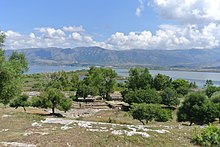Oricum
Oricum ( Greek Orikos ) was an ancient city in Illyria . It was located south of the Albanian port city of Vlora at today's Orikum , 42 kilometers from Apollonia , the largest ancient city in the region. Because of its protected harbor at the southern end of the deep bay of Vlora , the place was in military demand from antiquity to modern times.
Oricum was built on a 20 meter high hill, which lies on a narrow strip of land between the sea and the lagoon . The lagoon behind the city was also used as a port. At the highest point of the city there was a castle ( acropolis ); the castle hill covered an area of five hectares. Among other things, remains of the city fortifications and houses have been preserved, as well as stairs that open up the hill from several sides.
The oldest finds from Oricum, Proto-Corinthian sherds, date from the 6th century BC. Historical sources point to a mythical foundation by Greek settlers in the 8th century BC. BC, others to a later foundation by the Euboeans . Finds point to a connection with Corfu .
Oricum was repeatedly a theater of war. During the first Roman-Macedonian war , Philip V conquered in 214 BC. The city. During the Roman civil war between Caesar and Pompey , the former occupied the city in January 48 BC. Destruction by the side of the latter are likely to have brought about a gradual decline.
In Byzantine times there was a small port near the ancient city, which was called Ericho / Jeriko - the ancient name appears again in this name. In Ottoman times the port was named Paşaliman ( Port of the Pasha ).
The location of the ancient Oricum was identified by various explorers from Western Europe as early as the 19th century. In 1926, the Italian archaeologist Luigi Ugolini , who led excavations in Butrint and Phoinike , visited the site. In 1958 the theater from the 1st century was discovered. Since excavations in 2013 it was used as a water collection system from the 2nd century BC. Is understood. Further west, on the slopes of the Karaburun Peninsula , a necropolis has been discovered.
The excavations are currently not always easily accessible for visitors because they are located in the area of the Pashaliman military base .
literature
- Apollon Baçe: Qendrat e fortifikuara te gjirit te Vlores ne antikitet . In: Monumentet , 5 (1975).
- Dhimitër Budina: Germimet ne theatrin antik te Orikut. In: Studime Historike , 1 (1964).
- Dhimitër Budina: Oricum a la lumière des données archéologiques. In: Jadranska obala u protohistoriji. Kulturni i etnicki problemi. Zagreb, 1976.
- Christian Zindel: Orikos / Oricum . In: Christian Zindel, Andreas Lippert , Bashkim Lahi, Machiel Kiel (eds.): Albania. An archeology and art guide from the Stone Age to the 19th century . Böhlau, Vienna 2018, ISBN 978-3-205-20723-8 , pp. 334-342 .
Web links
- Website Archaeological Park (English)
- Olsi Lafe: Oricum (Albanian)
Coordinates: 40 ° 20 ′ N , 19 ° 28 ′ E

